14 Health Benefits of Baddha Konasana & How to Do It?
Physical activities have become mandatory to maintain fitness and health in this world of excessive work pressure. However, working for long hours without activities can cause spinal and back pain. Baddha Konasana is a yoga pose that helps to improve your posture, thereby eliminating such issues.
Learn about the various health benefits of Baddha Konasana or the Bound Angle Pose, the process involved, and the precautions you must take while practising.

Table of Contents

What is Baddha Konasana?
Baddha Konasana, or Bound Angle Pose, is the perfect yoga asana for opening the hips and stretching the inner thigh muscles. It is a Sanskrit term where "baddha” means bound, “kona” is angle, and “asana” means pose. This pose helps target various angles and body parts to enhance physical strength and endurance.
This pose is also known as the Butterfly pose. It resembles a butterfly since your feet are tucked close to your groin with clasped hands. It is also known as the Cobbler's pose since it resembles a cobbler at work. While practising Baddha Konasana, your back and core muscles keep working, improving their strength.
How to Perform Baddha Konasana (Bound Angle Pose)?
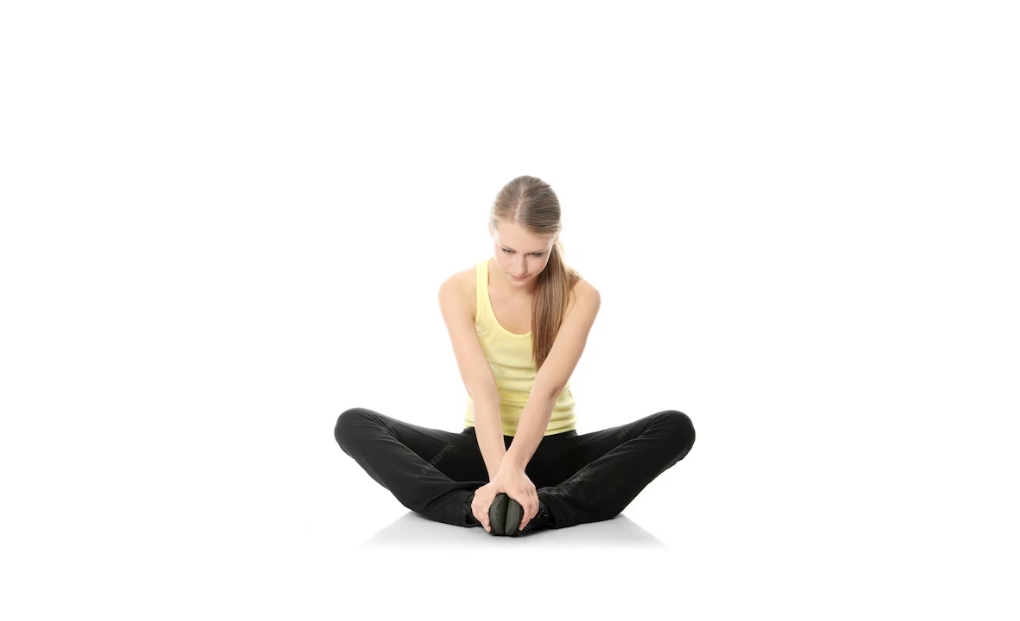
You must be curious to know how to perform Baddha Konasana. The following steps will help avoid making any mistakes:
Step 1: Start by sitting in Dandasana (Staff Pose), keeping your spine and back erect.
Step 2: Bend your knees and bring the soles of your feet together. Keep the heels close to the perineum and relax the thigh muscles.
Step 3: Now, hold your feet or ankles. Move your heels towards the groin as much as possible.
Step 4: Clasp your feet with both hands. Now, gently lift your knees off the floor while inhaling deeply.
Step 5: Breathe out and let your knees down to the ground. Keep your arms relaxed.
Step 6: Now, press your sitting bones on the floor. Point the crown of your head towards the ceiling to elongate your spine.
Step 7: Hold this pose and repeat it 10-30 times.
14 Health Benefits of Baddha Konasana
As this yoga position targets specific angles, Baddha Konasana can have multiple health benefits. Knowing about these will motivate you to perform it. Here are the common advantages you will find with Baddha Konasana.
1. Acts as a Hip Opener
Pain and tension in the hip joints are common in the current times of excessive work pressure and sedentary living conditions. Baddha Konasana acts as an excellent hip opener. When you sit in this pose, your sitting bones on the floor contribute to opening the hips, which helps to make your posterior feel lighter. This way, your hips receive gentle massaging and blood circulation, releasing tension and relaxing muscles.
2. Releases Fatigue and Tiredness
Feeling tired in the morning is a common problem, which continues throughout the day. An early morning practice of Baddha Konasana can be useful in getting rid of such issues. It helps to stay in meditation and targets various body parts, restoring energy and spirit. Practising it regularly will control your nerves and reduce the feelings of fatigue.
3. Improves Digestion
Digestion issues are common in recent times because of unhealthy eating practices. It can cause various challenges in daily life. Practising Baddha Konasana can be useful in improving the digestive system and stimulating its functions. It targets the abdomen and works on this area. As a result, you can avoid common diseases and digestion-related problems like constipation, bloating and irritable bowel syndrome.
4. Opens the Connective Tissues
The connective tissues in your body can cause pain and discomfort without stimulation or circulation. Usually, these tissues are connected so that blood circulation might be low. This can cause pain and cramps. With Baddha Konasana, you form a diamond shape, keeping your feet away from one another. It helps open the connective tissues and increases stimulation in these areas.
5. Relieves Stress
Regular stress from work and other complications of life is not rare in the current world. While there can be various means to reduce stress, Baddha Konasana is the easiest and most healthy way to do so. It improves your mental health by collecting your thoughts and helping you with meditation. During this time, you can review all the stressful events and develop positive thoughts.
6. Improves Mental Health
Baddha Konasana is a meditation pose that can improve your mental health. It is an ideal pose for reflecting on your activities and thoughts throughout the day. Moreover, rigorous and deep meditation can calm your nerves and help you impose better control over your emotions.
7. Ignites the Chakras
Various chakras in the human body play a part in mental well-being. This yoga asana targets two lower chakras, Muladhara and Sacral. While the former is connected with feelings of safety and security, the latter mainly deals with various emotional needs. Therefore, practising this asana helps stimulate your chakras, improving your physical and mental well-being.
8. Increases Flexibility
While practising Baddha Konasana, you must sit with widely stretched legs for a long time. This asana helps increase your flexibility in the inner thighs and groins. Moreover, this asana can also be effective for increasing the flexibility of your knees. It can improve overall posture and mobility for a long time.
9. Relieves Menstrual Discomfort
Menstrual cycles are inevitable and often bring pain and discomfort that are difficult to ignore. Practising Baddha Konasana can help you control these problems. It exercises the pelvic region, relieving pain and stiffness in the stomach, back, hips, and thighs. Therefore, it helps to reduce the pain and cramps during these cycles.
10. Improves Abdominal Health
The abdomen is responsible for multiple functions and activities. As Baddha Konasana targets the abdominal muscles and organs, it ensures proper maintenance of these parts.
Moreover, it looks after other organs, such as the ovaries, prostate gland, kidneys, and bladder. It can help you fight against common diseases and discomfort in these areas.
11. Helps to Deal with Urinary Disorders
Urinary diseases are common and extremely uncomfortable. Treatments might be lengthy and expensive. However, Baddha Konasana can improve the functioning of the overall urinary system.
This position stimulates the kidneys and bladder, improving blood circulation throughout the body. Moreover, it can strengthen the muscles in the pelvic and genitourinary regions, relieving the common symptoms of urethral strictures.
12. Reduces High Blood Pressure
Blood pressure fluctuations are a common problem for most people. Yoga postures like Baddha Konasana can be effective in reducing high blood pressure. They stimulate the heart and improve blood circulation.
In addition, long and deep breaths can effectively control your nerves, lowering the chances of high blood pressure.
13. Alleviates Sciatica Pain
Baddha Konasana can relieve sciatica pain by stretching the muscles and nerves of the lower back and buttocks. Regular practice of this pose may help reduce tension and compression on the sciatic nerve, easing discomfort and promoting healing.
14. Prepares for Childbirth
This pose benefits pregnant women as it helps open the pelvis, strengthens the pelvic floor muscles, and prepares the body for childbirth. It can also alleviate discomfort associated with pregnancy by relieving tension in the hips and lower back. As a seated pose, Baddha Konasana encourages relaxation and introspection.
The Mudras of Baddha Konasana (Bound Angle Pose)
In Baddha Konasana, several mudras can be incorporated to deepen the practice and enhance its benefits. Here are some mudras along with their incorporation and benefits:
1. Shuni Mudra (Life Force Mudra)
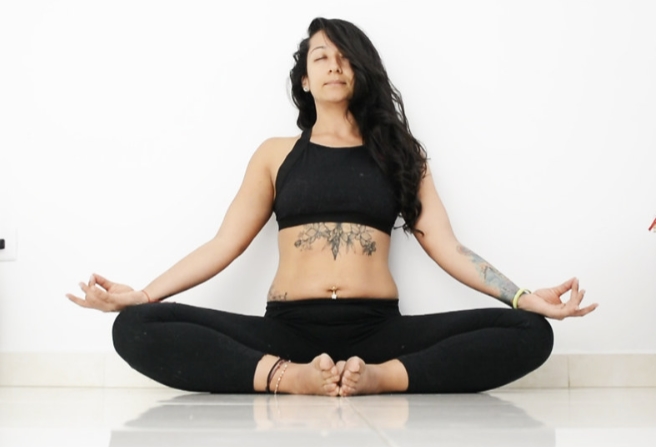
Shuni Mudra symbolises patience and discipline and helps us feel stable. To perform, bring the tip of the middle finger and thumb together, uniting the elements of fire and connection while keeping the other fingers extended.
Benefits of Shuni Mudra: Incorporating this mudra into Baddha Konasana can help encourage compassion, understanding and patience towards others.
2. Anjali Mudra (Salutation Seal)

Anjali Mudra symbolises unity, reverence, and gratitude. In Anjali Mudra, bring the palms together at the heart centre, pressing the hands firmly together while keeping the fingers pointing upward.
Benefits of Anjali Mudra: Incorporating this mudra into Baddha Konasana can help foster a sense of inner harmony, connection, and appreciation for the practice. It can also serve as a gesture of respect and devotion to the body and the journey of self-discovery through yoga.
Types of Baddha Konasana
There are several variations of Baddha Konasana, each offering unique benefits and challenges:
1. Baddha Konasana (Bound Angle Pose)
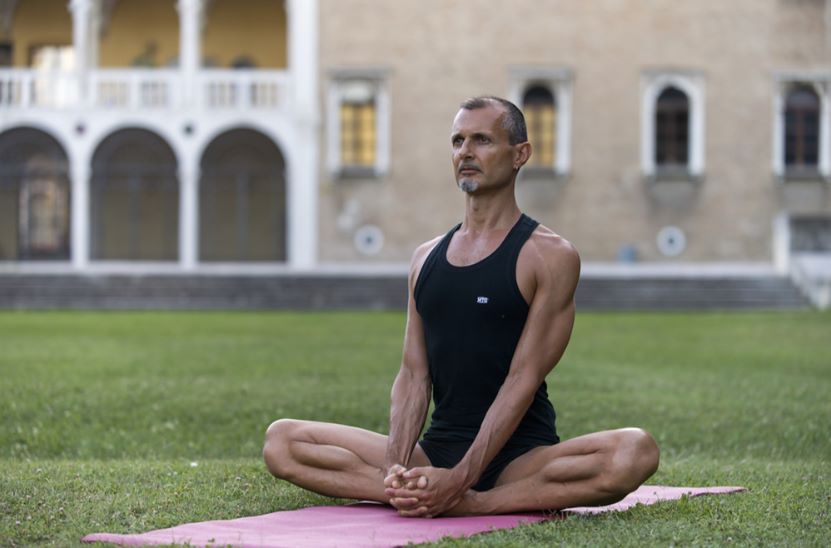
The traditional seated variation of Baddha Konasana involves sitting with the soles of the feet together, with knees opened wide, creating a diamond shape with the legs. The hands can hold onto the feet or ankles, and the spine is lengthened as the chest lifts and the shoulders relax away from the ears.
2. Supta Baddha Konasana (Reclining Bound Angle Pose)
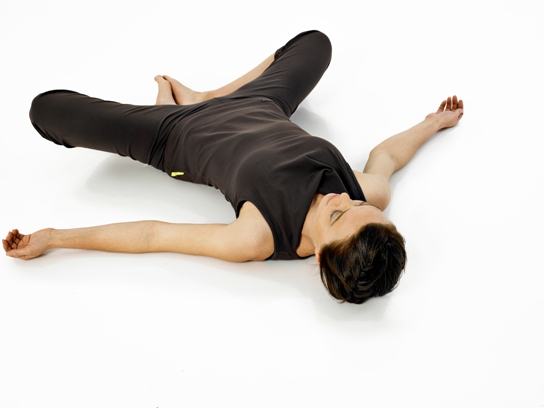
In this variation, the practitioner reclines onto their back and lays down thoroughly with the soles of the feet together and knees opened wide, creating a diamond shape with the legs. This variation provides a gentle stretch to the inner thighs and groin while promoting relaxation and relieving tension in the hips and lower back
3. Upavistha Konasana (Wide-Angle Seated Forward Bend)
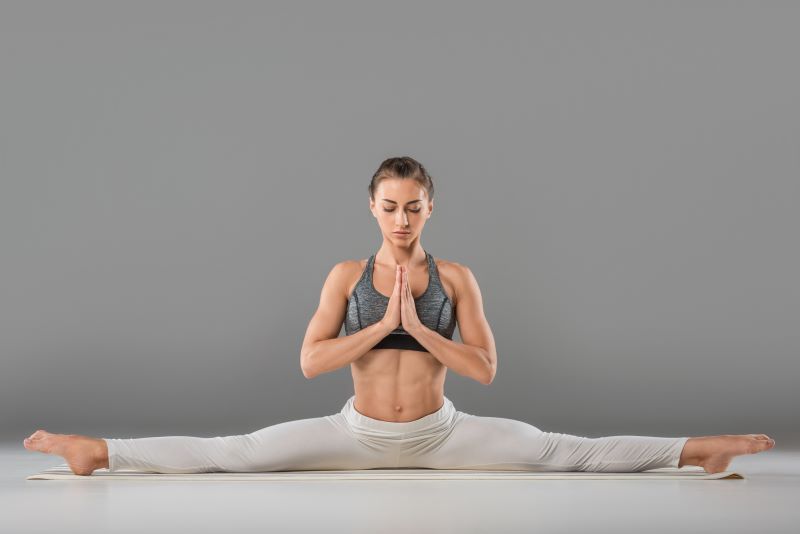
While not strictly a variation of Baddha Konasana, Upavistha Konasana shares similarities in the wide-legged seated position. In Upavistha Konasana, the legs are extended wide apart rather than bent with the soles of the feet together. This variation provides a deeper stretch to the inner thighs, hamstrings, and groins.
Things to Know Before Doing Baddha Konasana
You must consider several important points before starting the Baddha Konasana pose. Here are some essential things to know before attempting Baddha Konasana:
- Warm-up the Hips and Groins: Before practising Baddha Konasana, it's essential to warm up the hips and groins with gentle stretches and movements. This helps prepare the muscles and joints for the deeper stretch and reduces the risk of injury.
- Check for Proper Alignment: Pay attention to alignment cues such as keeping the spine straight, shoulders relaxed, and the pelvis in a neutral position. Ensure that the knees are open to the sides and the soles of the feet are pressed together.
- Modify as Needed: Baddha Konasana can be challenging for beginners or individuals with tight hips or groins. If needed, use props such as yoga blocks or blankets to support the knees or sit on a cushion to elevate the hips.
- Engage the Core Muscles: To protect the lower back and maintain stability in Baddha Konasana, engage the core muscles throughout the pose. Draw the navel toward the spine and avoid slumping or collapsing forward.
- Listen to Your Body: Remember how your body feels during the pose and avoid pushing into pain or discomfort. If you experience sharp or intense sensations, ease out of the pose slightly or come out entirely.
- Use Props for Comfort: Props can help maintain comfort and stability in Baddha Konasana. For example, you can place yoga blocks or blankets under the knees for support or sit on a folded blanket or cushion to elevate the hips.
- Focus on Breath Awareness: Cultivate awareness of your breath throughout the pose, breathing deeply and evenly to help relax the body and mind. Smooth, controlled breathing can also help release hip and groin tension.
- Practice Mindfulness: Baddha Konasana can be a meditative and reflective pose. Use this time to cultivate mindfulness, observing sensations in the body and thoughts in the mind without judgment.
How Long to Sit in Baddha Konasana?
Here's how long beginner, intermediate, and advanced level practitioners can aim to sit in Baddha Konasana (Bound Angle Pose):
- Beginners: Beginners should hold Baddha Konasana for a shorter duration to allow the body to adapt to the stretch and avoid strain. Aim to sit in the pose for about 1 to 2 minutes initially.
- Intermediate-Level Practitioners: Intermediate-level practitioners can aim to sit in Baddha Konasana for a moderate duration, between 3 to 5 minutes. You can gradually extend the hold to 5 minutes with consistent practice and improved flexibility.
- Advanced Practitioners: Advanced practitioners can sit in Baddha Konasana for an extended duration, ranging from 5 to 10 minutes or more. Advanced practitioners have developed greater flexibility and endurance, allowing them to sustain poses for longer periods.
The important thing is to gradually build your practice. However, always listen to your body and avoid pushing into discomfort or strain.
Risks of Overdoing Baddha Konasana
All yoga poses have various benefits. Here are some risks associated with overdoing Baddha Konasana (Bound Angle Pose):
- Strain on the Knees: Overdoing Baddha Konasana can strain the knee joints excessively, especially if the knees are forced too far down toward the floor.
- Hip Flexor Strain: Overstretching the inner thighs and groins in Baddha Konasana can strain the hip flexor muscles, mainly if the pose is too long.
- Lower Back Discomfort: Overarching the lower back or rounding the spine excessively in this pose can lead to discomfort or strain in the lower back muscles.
- Pelvic Instability: Overdoing Baddha Konasana without engaging the core muscles to support the pelvis can lead to pelvic instability and misalignment.
- Compression of the Sciatic Nerve: Overstretching the inner thighs and groins can compress the sciatic nerve, primarily if the pose is too long.
- Loss of Circulation: Overdoing the pose, if held for too long without proper alignment or support, can lead to decreased circulation to the legs and feet.
- Risk for Pregnant Women: Overdoing Baddha Konasana during pregnancy can put excessive pressure on the abdomen and pelvic floor muscles.
- Increased Risk of Injury: Overdoing any yoga pose beyond your current flexibility or strength increases the risk of injury.
To avoid risks, always practise Baddha Konasana in the correct form. Warm up beforehand so you don't feel muscle cramps. Discontinue the pose in case of pain or discomfort.
6 Tips for Practising Baddha Konasana
Performing Baddha Konasana can be challenging for beginners. Therefore, the following tips will be beneficial for them:
It is ideal to consult a fitness professional when performing this asana. Their advice will make achieving this position easier.
Initially, practise this asana for a lesser period. Then, slowly, the practice time will increase as the expertise grows.
If your knees feel uncomfortable in this position, move and spread your feet further out.
To intensify this routine, place your hands behind the outer thighs and pick up your hips about an inch off the floor.
You can use a blanket or cushion to support your sitting for a long time initially.
Practising it in the early morning is ideal to reap its benefits throughout the day.
What are the Precautions and Contraindications of Baddha Konasana?
Baddha Konasana is generally a simple yoga asana. However, it is not free of some precautions and contraindications. It is important to know these in advance to avoid common mistakes and negative consequences. These are as follows:
If you have a groin or knee injury, you should avoid practising Baddha Konasana, as it can pressurise these areas.
Those suffering from a torn ligament, worn-down joints, or rheumatoid arthritis should also avoid this asana. It might increase the pain and discomfort, triggering those muscles.
Younger people who have recently undergone knee, ankle or hip surgery should avoid practising this asana until they recover completely.
Pregnant women should avoid this yoga asana until they reach their second trimester. Hip opening before this time can lead to miscarriages.
If you have undergone trauma and are still struggling with mental health, it will be better to perform this initially with yoga professionals. It might bring back memories during meditation.
People with heart problems should avoid performing this yoga asana for a long time.
If you are suffering from Sciatica, do not try to stretch the back and spine beyond your capability.
Forcing your knees to stretch to push them to the ground can be dangerous, as it might lead to injuries and pain.
Who Should Avoid Doing Baddha Konasana?
The Baddha Konasana pose only suits some. Here are some individuals who should avoid practising Baddha Konasana:
- Recent Knee Injury: Individuals who have recently experienced a knee injury, such as a sprain, strain, or tear, should avoid practising Baddha Konasana. The pose can strain the knee joints, potentially increasing the injury or delaying healing.
- Chronic Hip Pain: People with chronic hip pain or conditions like hip bursitis, labral tears, or osteoarthritis should avoid Baddha Konasana. The pose can exacerbate hip discomfort and may worsen underlying hip conditions.
- Pregnant Women (Late Stages): Pregnant women in the later stages of pregnancy should avoid practising Baddha Konasana, especially if it causes discomfort or strain in the pelvis or abdomen.
- Recent Pelvic Surgery: Individuals who have undergone pelvic surgery, such as hip replacement or pelvic organ surgery, should avoid Baddha Konasana. The pose can strain the pelvic area and interfere with the healing process following surgery.
- Severe Lower Back Pain: People experiencing severe lower back pain or herniated discs, sciatica, or spinal stenosis should avoid Baddha Konasana. The pose can exacerbate lower back discomfort and may worsen underlying spinal issues.
- Limited Hip Mobility: Individuals with limited hip mobility or stiffness in the hip joints may find Baddha Konasana challenging or uncomfortable. Practising the pose without proper alignment or support can strain the hips and groins.
- High Risk of Blood Clots: People with a high risk of blood clots, such as those with a history of deep vein thrombosis (DVT) or pulmonary embolism, should avoid prolonged sitting in Baddha Konasana.
- Recent Abdominal Surgery: Individuals who have recently had abdominal surgery, such as hernia repair or abdominal organ surgery, should avoid Baddha Konasana. The pose can strain the abdominal area and interfere with the healing process following surgery.
What are the Easy Modifications of Baddha Konasana?
Knowing about the easy modification of Baddha Konasana will help you get started if you find it challenging to perform. Here are some easy changes that can help you out:
Reclined Goddess Pose (Supta Baddha Konasana) can replace this yoga position. It is a similar hip-opening position, except you lie down instead of sitting straight.
You can place some padding under your sit bones, such as blankets or cushions. This can be beneficial to prevent your hips from rounding forward or avoiding tight hips.
If your knees are far from the floor and feel painful, you can keep some yoga blocks under your knees. It will help to avoid discomfort.
If you are experiencing pain in your back or spine, you can sit against a wall to receive back support.
You can move your feet far from each other to avoid the pain and tightness in the knees.
Therefore, as you can see, Baddha Konasana can have multiple health benefits. It is a simple sitting asana that can act as a great hip opener. As this article pointed out, this asana can help you avoid various diseases and health complications. However, it is advisable to know its precautions to prevent negative consequences.














